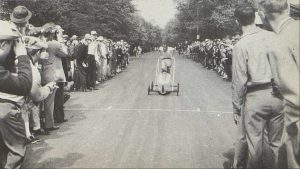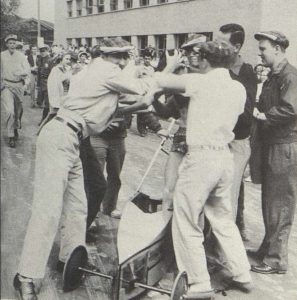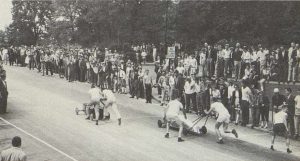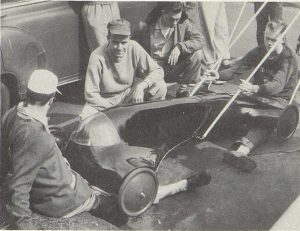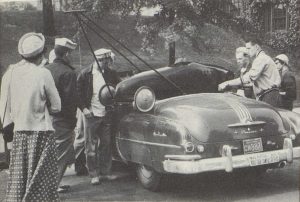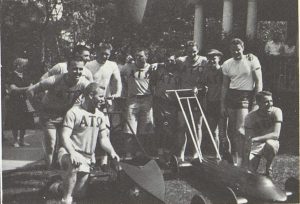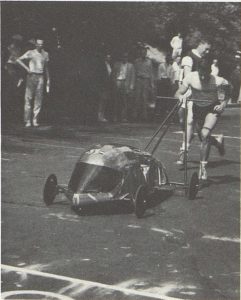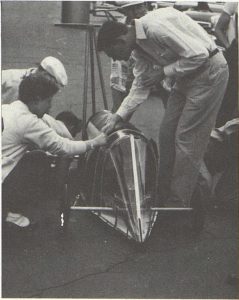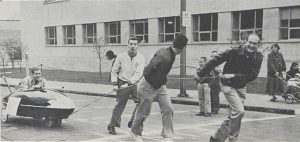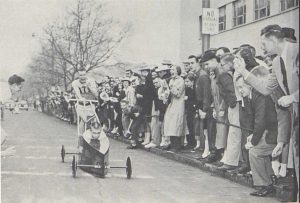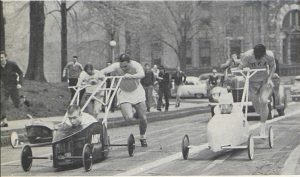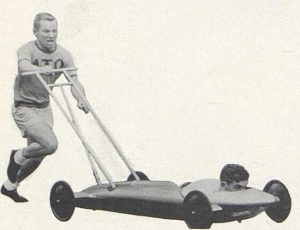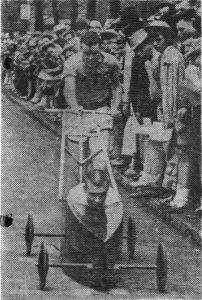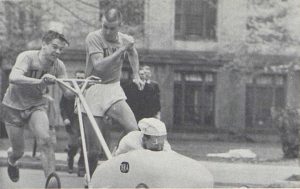Table of Contents: Intro & 1920; 1921-1923; 1924-1927; 1928-1932; 1933-1935; 1936-1939; 1940-1945; 1946-1949; 1950-1953; 1954-1956; 1957-1959; 1960-1963; 1964-1966; 1967-1969; 1970-1973; 1974-1976; 1977-1979; 1980-1983; 1984-1986; 1987-1989; 1990-1993; 1994-1996; 1997-1999; 2000-2003; 2004-2006; 2007-2009; 2010; 2011; 2012; 2013; 2014; 2015; 2016; 2017; 2018; 2019; Recap & 2020
This week, the 100 Years of Buggy History series takes a look at the mid-1950s The era saw the beginning of ATO’s domination, including the building of one of the greatest buggies of all time, the Golden Goose. Plus, we’ve got some interesting ATO-related stories courtesy of a 1983 Pittsburgh Press article, and The Tartan finally decides to print full results!
1954
Raceday: Prelims on Friday, May 14; Finals on Saturday, May 15
Sweepstakes Committee: Unknown
Race Results: (1) ATO (2:28.1 – COURSE RECORD); (2) PiKA; (3) DTD
Design Comp: (1) PiKA; (2) ATO
Weather: Cloudy, 56-68 Degrees on Friday; Partly Cloudy, 60-67 Degrees on Saturday
Sadly, the 1953-1954 Tartan is missing from the digital archives, so we don’t have much info about 1954 from the main source. But we do have a little bit of info, plus some interesting ATO stories from the mid-1950s.
- Raceday Incidents. We don’t have a ton of information about Raceday, and we don’t know how many entries there were. But what we do know, courtesy of the May 10, 1955 Tartan, is that 5 of the competitors failed to make it to the finish line. This was due to a combination of frozen bearings, thrown wheels, and spin outs. On another note, beginning in 1954 the Raceday broadcast (i.e., the loudspeaker services during the race) were provided by Scabbard and Blade, a military honor society.
- ATO’s Records. ATO set multiple course records in 1954. Their prelim time of 2:30.4 with Green Flash edged out their 1953 record by .15 seconds, and they topped it with a 2:28.1 while winning the Finals for a second year in a row.
- DTD’s Sudden Decline. DTD had the second fastest time in Prelims, though it’s unclear which of their two buggies did it (the “History of the Sweepstakes” article in the 1966 Buggy Book says that DTD’s 5-time winner, #12, was a DNF during the Prelims, but our photo of the starting line for the 1954 Finals indicates that #12 did advance), while PiKA’s new buggy finished 3rd. But in the Finals, DTD ran into trouble, as their bearings froze (per the 1966 “History of the Sweepstakes” article), leaving PiKA to take 2nd and DTD to settle for 3rd. 1954 spelled the end of DTD’s run at the top level of the sport.
- PiKA’s Design Winner. PiKA built a new buggy for 1954, which was a laminated wood buggy. That buggy was designed to look somewhat similar to ATO’s Andy I, and the design was good enough to win Design Comp and finish 2nd in the race. ATO, meanwhile, had their top buggy, Green Flash (which we think was a modified version of 1953’s #8, and would ultimately become Andy I), finish 2nd in Design Comp and win the race.
- Wheel Research. An article in the March 20, 1983 Pittsburgh Press, entitled “Calculated Craziness”, included some interesting stories about the mid-1950s. Donald H. Cookson II (E’57) was quoted in the article, providing some interesting color both for the mid-1950s in general, and specifically about his organization, ATO. He stated that some teams used motors (though they were easily caught, because you could hear them), and also said that the night before Raceday, teams would come to the track and pry up the “elephant feet” (lane markers riveted into the road) with a crowbar. He also claimed that ATO was the first to discover the benefits of heating wheels, which they learned accidentally. He said that one day they realized that times were getting faster as the buggy got more rolls, even though the pushers were tired. So on a hunch, they threw the wheels in the oven the next night before putting them on the buggy, and this time the buggy rolled faster than it ever had. But another year, an experiment they tried backfired. One of their physicists said that there was a high coefficient of friction between rubber and asphalt, so they tried to make aluminum tires to decrease the friction and improve their time. It was a poor decision; he claimed that it was the only time the buggy stopped in the freeroll.
- 1954 Photos. Below are some photos that we have from 1954.
1955
Raceday: Prelims on Friday, May 6 at 10:00am; Finals on Saturday, May 7 at 10:00am
Sweepstakes Committee: Unknown
Race Results: (1) ATO – Golden Goose (2:26 – COURSE RECORD); (2) ATO – Andy I (2:30.5); (3) PiKA (2:32.6)
Design Comp: (1) PhiKap; (2) ATO; (Honorable Mention) KapSig
Weather: Sunny, 58-63 Degrees on Friday; Sunny, 68-77 Degrees on Saturday
For the first time in history, the Tartan felt that Buggy results were important enough to actually print the full list! We’re working on updating the backend of our History database, and once that’s done these should be reflected there as well, but for now we’ll print them here.
- Never Trust a Weatherman in Pittsburgh. The May 3, 1955 Tartan warned spectators that they should bring raincoats to Raceday, as rain was expected, potentially causing issues for the races. However, as is usual in Pittsburgh, the weather reports were incorrect, and the days ended up sunny and relatively warm (particularly for Finals).
- ATO Builds Greatness. Although buggies did not formally have names yet, by the time the 1950s rolled around, the buggies on the course started to be a little more consistent (as opposed to the 1920s and 1930s, when buggies were typically either built from scratch, or at least modified in some way, every year). And so it was around this time that some received names. The winning buggy from 1954, which was often referred to as “Flash” or “Green Flash”, was a 1-hit wonder in that configuration, though we believe it was modified into what became named Andy I. Meanwhile, the brothers decided to go with something new in 1955. The May 10, 1955 Tartan referred to the creation as “midget flash”, since it was a smaller version of the 1954 buggy, and described it as a “copper-colored, cigar-size speedster” that went on to take 2nd place in Design Comp and win the race. But the creation would ultimately come to be known by a much more familiar name in the Buggy community – Golden Goose.
- Remember to Breathe. Speaking of the Golden Goose, we don’t know exactly when this happened, but an interesting story was published in the March 20, 1983 Pittsburgh Press in an article entitled “Calculated Craziness”. One of the stories told in the article by Donald H. Cookson II (E’57), a member of ATO, was related to an ATO buggy incident in the mid-1950s. Apparently, the Golden Goose was sealed tight (not surprising, if you look at the photos), and in order to breathe the driver would suck air through a tube (like a snorkel). Mr. Cookson said that one night, while practicing for Raceday, he shoved the buggy at the top of Hill 2, but due to some malfunction, the breathing tube no longer connected the driver’s mouth to the outside air. The driver passed out in the buggy due to a lack of oxygen and the buggy, now in the freeroll, began weaving wildly down the street. The buggy hit one curb, then careened off of that and hit the other curb, before bouncing back and hitting the first curb again, finally coming to a stop. The brothers pulled the driver out of the buggy and he awoke, but it was a scary moment for the team.
- The First (and Only) Truly Independent Organization. We noted that the first non-Greek organizations permitted to race were the Men’s Dorms and the Citcom Clan, and other “independent” buggy teams (as we know them now) did not really participate until Fringe’s debut in 1969. But in 1955, we had an exception, with a very independent team. An organization known as Harry’s Boys Club decided to field a team. Harry’s Boys Club had sponsored the winning Pitt buggy in 1954, so they decided to branch out and recruited a number of CMU track team members to push their buggy with hopes of winning all of the Pittsburgh Buggy Races. Unfortunately for them, CMU’s race was probably more competitive; the team was barely able to crack the Top 10.
- Raceday Results. There’s not much to say about the race itself because it was pretty uneventful. 17 teams (13 organizations) entered, 17 reached the starting line, and 17 finished the race. Based on those numbers, I assume that there were 6 Prelim Heats in total, and per the May 10, 1955 Tartan, none of those heats were particularly close. PiKA’s 3rd place finisher came out of Heat 3, where it rolled a 2:34, which was the fastest time to that point. In Heat 4, ATO’s Andy I (identified in the May 10, 1955 Tartan as the “blue ATO buggy”) bested that time with a 2:33.7. Then in the final heat, ATO’s Golden Goose nearly set a new course record with a 2:28.3, just .2 off of the record set in 1954. Those 3 went on to compete in the finals and stayed in that order in a competitive race, with ATO’s Golden Goose setting the course record in a 2:26 and just 6 seconds separating all 3 teams. The full results were:
- ATO (Golden Goose) – 2:26
- ATO (Andy I) – 2:30.5
- PiKA – 2:32.6
- PiKA – 2:43.5
- KapSig – 2:45.5
- KapSig – 2:46.3
- PhiKap – 2:48.2
- SAE – 2:52.2
- Harry’s Boys Club – 2:53.1
- Theta Xi – 2:53.8
- Beta – 2:58.1
- DU – 2:59.3
- Beta Sigma Rho – 3:02.4
- DTD – 3:06.2
- SigNu – 3:14.4
- Beta – 3:39.3
- Tau Delta Phi – 3:48.8
- PhiKap’s Design Bona Fides. PhiKap’s buggy, described as a “beautiful black buggy”, did what it needed to do on Raceday by finishing in the top half of the competition, and that was enough to earn PhiKap the Design Competition trophy, something they achieved consistently during the 1950s.
- 1955 Photos. Below are some photos from 1955, including some unidentified buggies, so let us know if you recognize them!


1956
Raceday: Prelims on Friday, May 4 at 10:00am; Finals on Saturday, May 5 at 10:00am
Sweepstakes Committee: Tom Wright (ATO) (Chair)
Race Results: (1) ATO – Andy I (2:25 – COURSE RECORD); (2) PiKA – Cheetah (2:30.2); (3) PiKA – Shark (2:32.6)
Design Comp: (1) ATO; (2) PiKA
Weather: Cloudy, 47-58 Degrees on Friday; Mostly Cloudy, 50-60 Degrees on Saturday
1956 saw a dominant top 2 teams, where the only question was which 3 of their 4 buggies would make the Finals. Also, a pusher learned his lesson the hard way.
- ATO Goes Practice Crazy. ATO wasn’t satisfied with their mere 2-race win streak and multiple course records set every year. They wanted more. The March 13, 1956 Tartan notes that ATO’s team was already out practicing with their practice buggy, even though Raceday was nearly 2 months away (most teams only began practicing 1-2 weeks before Raceday). The Tartan also suggests that other teams might want to get out there as well.
- Radio Debut. WRCT made its debut at CMU back in 1949. It’s unclear if they were involved in any of the earlier broadcasts, but by 1956 they had coverage. The April 17, 1956 Tartan noted that WRCT was planning to conduct interviews with the winning drivers and builders. But that’s not all – KDKA got involved! On May 8, 1956 at 10:05pm, KDKA aired a 15 minute recap of Spring Carnival, including a breakdown of the races (we’re trying to find a copy of that broadcast…if you’ve got any connections, let us know!). Of course, it wasn’t just broadcasting…there was also a “rumor” that WRCT was building a buggy, that was remote-controlled and included a built-in TV set. Obviously that didn’t end up happening, but we do have a photo of WRCT with “their” buggy.
- Large Greek Field Takes Shape. Early reports not only had WRCT considering buggy, but also suggested the Mortar Board, the senior women’s honorary organization, would be entering a buggy. However, neither of those organizations opted to compete. Instead, 19 buggies from 11 organizations, all fraternities, ended up on the starting line.
- Too Much Speed? Teams always want to go fast, and for decades they’ve been looking for an edge in doing so. The May 1, 1956 Tartan reported that several organizations had paid over $100 for wheel bearings from Switzerland. But with that comes peril, as the May 8, 1956 Tartan argued that there was more of an emphasis being placed on speed rather than safe construction or careful driving. This came to fruition in the form of on-course incidents. There were 2 collisions during Prelims on Raceday, though we don’t have details about who was involved. The one other incident that we do know about involved one of KapSig’s buggies, which ran over a pusher during the race, though no one was seriously injured.
- Prelim Results. There was a clear top tier when it came to the race, and that tier was occupied by ATO and PiKA. Each entered 2 buggies and were easily the top 4 times in Prelims, with ATO’s Andy I topping the list in 2:28.6. However, only 3 of those 4 would advance to the finals, and unfortunately for ATO, they were the low org on the totem pole, with their Golden Goose finishing just 1 second behind PiKA for 3rd (PiKA’s buggies ran 2:30.9 and 2:32.0). The biggest surprise of the day was Beta, whose newly built buggy finished 6th, a significant improvement over their 12th place finish from the prior year.
- ATO’s Special “Motor”. As the Finals began, ATO’s Hill 1 and Hill 2 pushers, D. Ritchie and Richard Major, gave ATO a lead going into the Freeroll that they wouldn’t relinquish. The buggy expanded its lead during the Freeroll, and although PiKA closed the gap slightly on the back hills, ATO’s Hill 5 pusher, Dick Swaney (E’57), the track captain and Tri-State Meet quarter-mile champion, powered ATO to victory in a course record 2:25.0, 5 seconds ahead of PiKA.
- Full Results. As we work to update the History tab of our website, the full 1956 Results are as follows:
- ATO (Andy I) – 2:25.0
- PiKA (Cheetah) – 2:30.2
- PiKA (Shark/S-1) – 2:32.6
- ATO (Golden Goose) – 2:33.0
- DTD – 2:40.0
- Beta – 2:42.1
- PhiKap – 2:45.1
- KapSig – 2:48.9
- Beta Sigma Rho – 2:52.7
- SigNu – 2:54.2
- PhiKap – 2:56
- KapSig – 2:56.5
- DU – 2:56.9
- Theta Xi – 3:03.5
- SAE – 3:09.2
- Beta – 3:11.2
- DTD: 3:22.1
- 1956 Photos. Here are a few additional photos from 1956.
- 1956 Video. We’ve also got two different videos of the 1956 Finals! One is an aerial video from a helicopter, and one is ground-level (which also got a shot of the helicopter).



